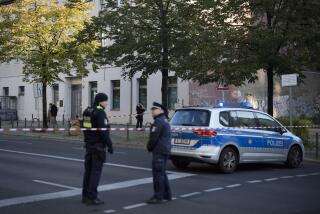Downey Jews Remember ‘Night of Broken Glass’
- Share via
Harry Bachenheimer was 14 when he saw storm troopers smash and burn his temple, as shredded prayer books littered the streets of Hamburg, Germany. Fifty years later, he remembers it as if it were yesterday.
It is a memory he wants others to share.
So he and nine fellow members of Temple Ner Tamid in Downey have written about their experiences in a booklet recounting the 1938 horror of Kristallnacht.
Dubbed by the Nazis as the “Night of Broken Glass,” Kristallnacht is historically recognized as the first premeditated assault against Jews in Germany and Austria.
“The nation responsible for the sensitive, artistic products of great minds as Wagner, Goethe, Schiller, Heine and others was destroying the Jewish people by destroying our homes, synagogues and throwing our heritage to the wind,” wrote Bachenheimer, now 64.
Planned for Months
Kristallnacht began the night of Nov. 9 and ended the next morning. It had been planned months in advance and needed only a spark to set it off. That came when a young Polish Jew, Herschel Grynzspan, assassinated German diplomat Ernst von Rath at the German Embassy in Paris.
The death toll in the two countries included 36 Jews, and thousands more were injured or subsequently perished in concentration camps. About 7,500 Jewish homes and businesses and 1,118 synagogues were destroyed or damaged during the 2 days, according to historians.
This year marks the 50th anniversary of Kristallnacht , which most Jews and historians consider the beginning of the Holocaust. To commemorate the event and preserve their personal accounts for future generations, the Downey temple produced its 37-page booklet for distribution at a service on Friday.
In Bachenheimer’s account, he tells how he watched Nazis try to exchange goods they had stolen and damaged when smashing his parents’ store. A woman tells of not being able to leave her school in Darmstadt to visit her parents in Reichelsheim--about 20 miles away--because of the danger to Jews traveling in Germany. Another woman recalls how in 1943 she and her boyfriend--whom she later married--leaped from a train bound for a concentration camp and remained in hiding for 2 years before fleeing to the United States.
The booklet is not a definitive document, but a recollection of things that happened to everyday people, Rabbi Michael Mayersohn said.
Mayersohn started developing the booklet in June when he asked members of his congregation to write accounts of Kristallnacht . He received a melange of stories, ranging from one paragraph to 10 pages.
Reliving Bitter Memories
The booklet “is an opportunity to preserve the memory of survivors and teach the younger generation--including the young adults--of the experience of the Jews before the Holocaust,” Mayersohn said.
Mayersohn said he plans to distribute the booklet to members of the congregation, city and school officials and Downey school principals.
For many of its contributors, writing the accounts meant reliving bitter memories and remembering “the frustration of being a ‘German Jew’ and realizing that you were Jewish, but not considered German,” Bachenheimer said.
“Writing was a catharsis for me,” said Dena Taslitt, 56. “I wrote so my children and grandchildren could read it in a capsulized version. In another 10, 15, maybe 20 years, anyone who’s a survivor of Kristallnacht or a camp is going to be gone.”
For Bachenheimer, “the greatest satisfaction would be that German children would read my story one day and realize what the German people had done,” he said.
“Besides those who died,” as his account concludes, “many had tremendous hardship. But those of us who survived to build a new life.”
More to Read
Sign up for Essential California
The most important California stories and recommendations in your inbox every morning.
You may occasionally receive promotional content from the Los Angeles Times.










